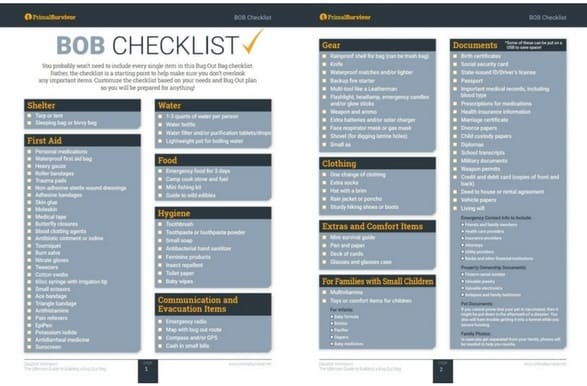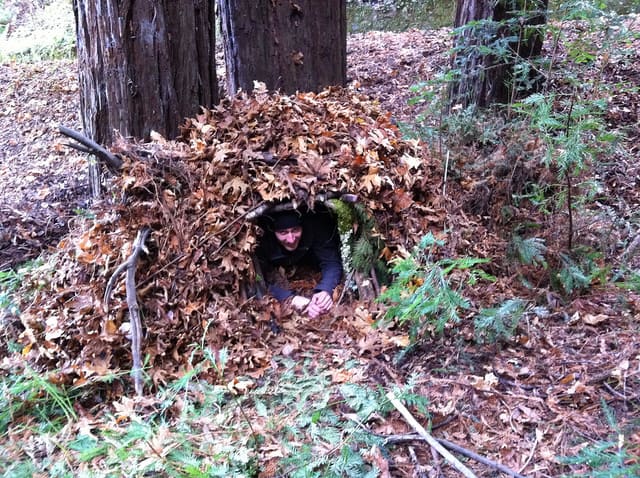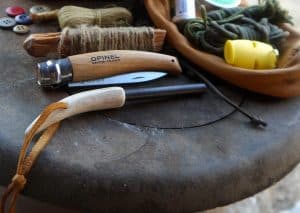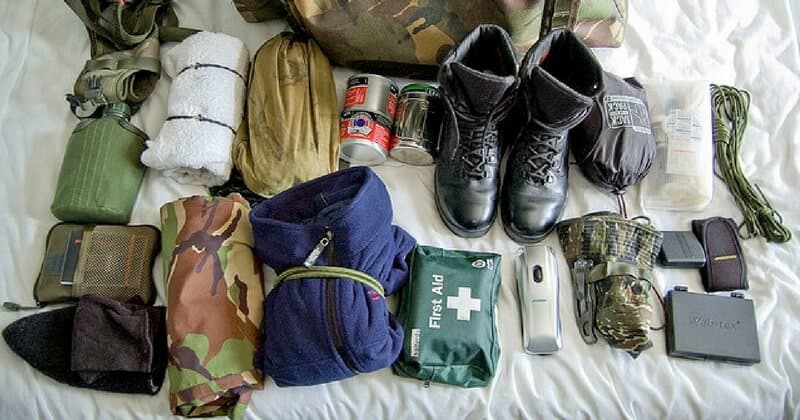[ad_1]
The term Bug Out Bag (also called a “Go Bag” or a “72-Hour Survival Kit”) can be off-putting to a lot of people.
It makes it seem like you’re eagerly awaiting a chance to go berserk in the wilderness. Urban Dictionary even defines Bug Out as “an act of freaking out over usually nothing; overreacting.”
BUG OUT BAG CHECKLIST

Get organized fast with our completely free checklist.
Everyone Needs a Bug Out Bag
Terminology aside, a Bug Out Bag is essential to disaster planning and preparedness. Disasters can strike at any moment and can be more common than you would expect.
Even if you think these disasters will never occur, isn’t it better to be safe than sorry? I sleep better knowing I’ve done everything in my power to keep my family safe!
Why a Three-Day Bug Out Bag?
As a report from the Heritage Foundation says, local governments are often overwhelmed during large-scale disasters. They rely on state and federal governments to help in these situations. However, it takes an average of 72 hours for state and federal governments to respond.
Because you can’t rely on the government to help you immediately (or at all, depending on the type of disaster), you should be self-sufficient for at least three days.
Some people prefer to make their Bug Out Bags for even longer periods.
What to Put in Your Bug Out Bag
There are many Bug Out Bag lists out there that will tell you exactly what to pack. However, these lists ignore the fact that everyone has different survival needs.
Please don’t follow any Bug Out Bag checklist blindly. Instead, think about the following:
- The conditions where you live
- The most likely disasters to occur in your area
- How many people will be in your group
- Special considerations for people in your group (such as children, elderly, and health issues.)
To ensure no critical item gets overlooked on the Bug Out Bag list, I encourage people to divide the gear into categories based on goal/task.
These categories are the essentials you will need to stay alive.
BOB Gear Category 1: Water
Water is your #1 most important item for survival in a disaster situation. Depending on the disaster, the normal water sources may be completely contaminated – such as after a nuclear attack.
- Water: Your Bug Out Bag water items should include 1-3 quarts per person. This is estimating that you will drink 1 quart of water per day.
- Water Bottle: You’ll also need a device for carrying water, such as a water bottle or camelback.
- Water Treatment Method: Never drink water without treating it first. I like the Sawyer Mini water filter because it is just 2 ounces and filters up to 100,000 gallons of water. However, it won’t remove viruses, so it isn’t suitable for urban water sources. I recommend reading this post on disaster water purification.
BOB Gear Category 2: Shelter and Warmth

Image credit: “Wilderness Skills Clinic” (CC BY-NC 2.0) by borkazoid
For most, shelter probably means using a tarp or a tent. There is considerable debate about whether a tarp or tent is best for your Bug Out Bag. It really comes down to your level of experience. If you don’t have experience sleeping in tarp shelters, go for a tent.
Choose a tent that has the highest hydrostatic head rating you can find while still being lightweight.
The rating tells you how well it will withstand water (as well as its ability to resist snags). Don’t go with anything less than a 2500 rating!
You will also need a sleeping bag, bivvy bag, or emergency blanket for each person.
I recommend that you familiarize yourself with the many types of survival shelters and learn how to make a shelter out of debris. You never know if your tent will get lost or stolen, so this knowledge could save you!
BOB Gear Category 3: Food Supplies
According to the survival rule of three, you can go 3 weeks without food. But that doesn’t mean you shouldn’t include food in your Bug Out Bag list. People get grumpy and angry when hungry.
Choose non-perishable, high-protein, and high-fat foods (you’ll need the energy!). You’ll probably want to avoid canned goods because they are so heavy.
If you aren’t sure what food is suitable, read this post for 50+ Bug Out Bag Food Ideas.
BOB Gear Category 4: Fire

Fire isn’t just about warmth.
- It will help keep wild animals away.
- A lit branch can be wielded as a weapon.
- Fire can be used as a signal.
- Fire can be used to boil water for drinking and first aid.
BOB Gear Category 5: Self-Defense Items
I’ve met people with a complete weapons arsenal in their Bug Out Bags. A firearm certainly seems like a good idea; you can read more about the best bug out guns here. However, multiple firearms are just likely to weigh you down.
You may also want to consider pepper spray for your BOB. It is a great non-lethal weapon.
BOB Gear Category 6: Hygiene Items
You won’t need much for hygiene, so don’t bring shampoos or deodorants. Here are some essentials:
- Baby wipes
- Small bar of soap
- Toothbrush and toothpaste (or tooth powder) – Emergency Dental Kit Checklist
- Feminine hygiene items
BOB Gear Category 7: Clothing
When it comes to clothes for your Bug Out Bag, you don’t need more than a spare shirt and pants. Who cares if you are stinky and dirty – you will be alive!
As for the selection of clothes, choose wool items or camping clothes (usually synthetics) because they dry quickly.
If you get wet while bugging out, it could quickly lead to hypothermia, so you want to have that rain jacket, dry clothes, and socks to change into.
A wide-brimmed hat is also suitable for keeping rain and sun out of your eyes.
I keep extra socks in my BOB because keeping your feet dry is so important. I also have my boots next to my BOB in case of SHTF while wearing sneakers or sandals.
Recommended reading:
BOB Gear Category 8: First Aid Kit
As for first aid, stick to the essentials. You don’t need a tourniquet in this kit, but you will need a multi-purpose tool like a Leatherman, which has small scissors, bandages, antiseptic wipes, and burn gel.
Read this post for a Checklist of First Aid Items for Your Bug Out Bag
BOB Gear Category 9: Multifunctional Emergency Gear and Tools
Imagine all of the obstacles and dangers you might encounter when fleeing a disaster.
- There might be broken glass all over the place.
- You might need to break into a building for shelter.
- You might need to walk in the dark.
- There might be dangerous chemicals in the air.
These obstacles can be overcome with gear such as heavy-duty gloves, a crowbar, flashlight, and face mask.
To ensure you don’t miss anything, do your best to visualize what could happen during a disaster. These types of gear are included in the Bug Out Bag checklist below.
However, everyone’s Bug Out Bag list will be different, so it pays to visualize potential disaster scenarios.
BOB Gear Category 10: Vital Documents
Finally, don’t forget to include all the essential documents you might need in an emergency, such as your ID, passport, phone numbers, and photos of family members (in case you get separated).
Our Emergency Binder template will come in handy for this; it is a binder of forms and worksheets that anyone can quickly fill out. Type your info into the PDF, save a digital copy, and print out a copy—view Template.
Bug Out Bag List
Click to download a PDF of this checklist.
- Water: 1-3 quarts per person
- Water bottle
- Water treatment method: Such as a filter, water purification tabs, etc.
- Tent or tarp
- Sleeping bag, bivvy bag, or emergency blanket
- Survival food: Such as protein bars or MREs
- Firestarter
- First aid kit: See checklist of Bug Out Bag first aid items
- Self-defense weapon: Such as a firearm or pepper spray
- Hygiene kit: Toothbrush and paste, baby wipes, TP, feminine items
- Change of clothes
- Rain jacket
- Brimmed hat: To protect your eyes from sun and rain.
- Boots
- Survival knife: Read about the best cheap survival knives.
- Paracord
- Heavy-duty survival gloves
- Face mask: Read how to choose a face mask here.
- Emergency light: Such as a headlamp, hand crank flashlight, chemical lights…
- Emergency radio: Read how to choose an emergency radio here
- Vital Documents: Read what vital documents to pack here
- Cash: At least $50 is recommended
- Compass
- Maps: With evacuation route marked
- Waterproof cover and dry sack
(Optional Items)
- Survival stove and cook set
- Crowbar
- Lock picking set
- Folding saw
- Sewing kit
- Survival guides: See our guide to the top prepping and survival books here
- Spare glasses and glasses case
- Folding shovel: Guide to best survival shovels here
- Trash bags
- Spare batteries
- Charging kit: Read about the best portable solar power bank.
- Duct tape
- Hand warmers
- Comfort and personal items: Such as toys for kids, playing cards, a book
See our checklist bundle for printable versions of this checklist and 16 others.
Extra Tips
1. Cut Weight
Hanging out with ultra-light backpackers has taught me a lot about reducing weight from my pack. These are people who know that every ounce counts.
An ounce might not seem like a lot – until you consider that it only takes 16 ounces to make a pound. Doing things (which might seem crazy at first) like cutting the edges off of your maps, those ounces can quickly add up to significant savings.
Backpackers say you should only carry 15% to 25% of your body weight. However, that’s backpacking. We are talking about bugging out. You might need to run with your pack on – so cutting weight is even more critical.
If your pack weighs more than 30lbs, I suggest reading this post on How to Cut Weight from Your Bug Out Bag. Some of the things you’ll need to focus on are:
2. Leave Some Room
This tip doesn’t get mentioned much. Instead, most people seem to encourage preppers to fill their BOBs to the max.
You should leave room in your BOB because you never know what you will find.
- You find someone else’s abandoned gear and want to take it with you.
- You come across a bunch of wild edibles and decide to carry them with you.
- You find some plastic bottles and want to take to carry extra water.
- It looks like it will rain, so you want to put dry tinder in your bag for later…
3. Be Willing to Pay for Quality Survival Gear
I don’t believe you need to spend a fortune to prepare for a disaster. Do what you can with your allotted budget.
But let’s be honest. While a $5 flashlight is better than no flashlight, it probably isn’t going to withstand the elements very well!
Not all of your gear needs to be super high-quality. To make the most of your budget, prioritize items. These are the ones I believe to be the most important:
- Survival knife: See these best survival knives under $100
- Tent: Tents are very heavy. So, choose a lightweight model if you choose a tent instead of a tarp. Good lightweight tents are pretty pricey.
- Waterproof Gear: Cheap ponchos tear easily. Spend the extra money to buy quality rain jackets for your Bug Out Bag.
- The Bug Out Pack: As someone who goes backpacking a lot, I can tell you that pack quality matters! A crappy pack will strain your shoulders and back, and the straps might break quickly. Read this post about how to choose a survival backpack.
4. Keep Your Boots Next to Your Bug Out Bag
Whether you plan on bugging out in the city or remote wilderness, boots are likely a must-have. You’ll need boots to protect your feet from rubble like broken glass, flaming debris, and tough terrain.
The problem is that many of us don’t wear our boots every day. Thus, we keep our boots next to our BOBs to quickly put them on in case we need to flee.
5. Have Multiple Bug Out Bags
A BOB at home isn’t won’t do much good if disaster strikes while you are at work. Make multiple BOBs and keep them at:
- Home
- In your car
- At work
- Anywhere else you are frequently
Additionally, you will want to have a Get-Home Bag in your car.
6. Plan for Rain and Freezing Temperatures
Bugging out on a nice summer day is fine. You could probably even survive with no gear (though not very comfortably or safely).
When the weather gets bad, though, things are tougher! Here are some of the things that can happen with rain or cold:
- Your BOB contents get completely wet. With no dry clothes to wear, you suffer hypothermia.
- Your water filter freezes in the cold, something which ruins many filters.
- Your fingers are so cold that you can’t use your knife to shave tinder off sticks for lighting a fire.
- There is so much snow that you are unable to build a shelter.
These problems (and many others) can be avoided with careful planning. For example, you’ll probably want to bring a survival shovel for building a snow cave. Use a wet sack inside your Bug Out Bag to keep items dry.
7. Test, Test and Test Again!
The most crucial piece of prepping advice (whether for bugging out or hunkering down) is to run a survival drill.
Follow your Bug Out Plan using just the items in your BOB.
How well were you able to survive?
Chances are you will come up with flaws in your BOB contents – like realizing that your knife is not suitable for batoning wood or your pack is too heavy to carry long distances.
That is what prepping is all about: Strategizing, testing, and adjusting plans.
No plan is perfect, but with drills and careful planning, you can get it as nearly perfect as possible.
FAQ
Hikers use a general rule that your pack should be less than a quarter of your body weight, but they are not bugging out where you may need to run or hide. For a Bug Out Bag, we suggest aiming for 10 to 15% of your body weight; for a 200lb adult, aim for a 20lb pack.
This depends on many factors and, of course, your physical fitness. But as a general rule, 30 liters is a good size Bug Out Bag for an average adult.
You should carry 1 to 3 Quarts of water per person and have a water filter and bottle to replenish supplies.
You should aim to pack enough to survive for 72 hours in an emergency. This will give you enough time to evacuate from a disaster and wait for federal or government response.
[ad_2]
Source link

